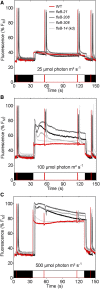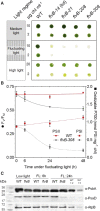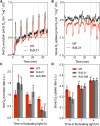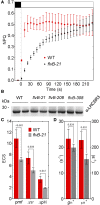Flavodiiron Proteins Promote Fast and Transient O2 Photoreduction in Chlamydomonas
- PMID: 28487478
- PMCID: PMC5490913
- DOI: 10.1104/pp.17.00421
Flavodiiron Proteins Promote Fast and Transient O2 Photoreduction in Chlamydomonas
Abstract
During oxygenic photosynthesis, the reducing power generated by light energy conversion is mainly used to reduce carbon dioxide. In bacteria and archae, flavodiiron (Flv) proteins catalyze O2 or NO reduction, thus protecting cells against oxidative or nitrosative stress. These proteins are found in cyanobacteria, mosses, and microalgae, but have been lost in angiosperms. Here, we used chlorophyll fluorescence and oxygen exchange measurement using [18O]-labeled O2 and a membrane inlet mass spectrometer to characterize Chlamydomonas reinhardtii flvB insertion mutants devoid of both FlvB and FlvA proteins. We show that Flv proteins are involved in a photo-dependent electron flow to oxygen, which drives most of the photosynthetic electron flow during the induction of photosynthesis. As a consequence, the chlorophyll fluorescence patterns are strongly affected in flvB mutants during a light transient, showing a lower PSII operating yield and a slower nonphotochemical quenching induction. Photoautotrophic growth of flvB mutants was indistinguishable from the wild type under constant light, but severely impaired under fluctuating light due to PSI photo damage. Remarkably, net photosynthesis of flv mutants was higher than in the wild type during the initial hour of a fluctuating light regime, but this advantage vanished under long-term exposure, and turned into PSI photo damage, thus explaining the marked growth retardation observed in these conditions. We conclude that the C. reinhardtii Flv participates in a Mehler-like reduction of O2, which drives a large part of the photosynthetic electron flow during a light transient and is thus critical for growth under fluctuating light regimes.
© 2017 American Society of Plant Biologists. All Rights Reserved.
Figures








Similar articles
-
The Liverwort, Marchantia, Drives Alternative Electron Flow Using a Flavodiiron Protein to Protect PSI.Plant Physiol. 2017 Mar;173(3):1636-1647. doi: 10.1104/pp.16.01038. Epub 2017 Feb 2. Plant Physiol. 2017. PMID: 28153920 Free PMC article.
-
Chlamydomonas Flavodiiron Proteins Facilitate Acclimation to Anoxia During Sulfur Deprivation.Plant Cell Physiol. 2015 Aug;56(8):1598-607. doi: 10.1093/pcp/pcv085. Epub 2015 Jun 10. Plant Cell Physiol. 2015. PMID: 26063391 Free PMC article.
-
Flavodiiron-Mediated O2 Photoreduction Links H2 Production with CO2 Fixation during the Anaerobic Induction of Photosynthesis.Plant Physiol. 2018 Aug;177(4):1639-1649. doi: 10.1104/pp.18.00721. Epub 2018 Jul 5. Plant Physiol. 2018. PMID: 29976836 Free PMC article.
-
Photoprotection of photosystems in fluctuating light intensities.J Exp Bot. 2015 May;66(9):2427-36. doi: 10.1093/jxb/eru463. Epub 2014 Dec 1. J Exp Bot. 2015. PMID: 25468932 Review.
-
Role and regulation of class-C flavodiiron proteins in photosynthetic organisms.Biochem J. 2019 Sep 13;476(17):2487-2498. doi: 10.1042/BCJ20180648. Biochem J. 2019. PMID: 31519856 Review.
Cited by
-
Extra O2 evolution reveals an O2-independent alternative electron sink in photosynthesis of marine diatoms.Photosynth Res. 2024 Jan;159(1):61-68. doi: 10.1007/s11120-023-01073-3. Epub 2024 Feb 5. Photosynth Res. 2024. PMID: 38316719
-
Strategies to Study Dark Growth Deficient or Slower Mutants in Chlamydomonas reinhardtii.Methods Mol Biol. 2021;2297:125-140. doi: 10.1007/978-1-0716-1370-2_13. Methods Mol Biol. 2021. PMID: 33656676
-
Effects of High Irradiance and Low Water Temperature on Photoinhibition and Repair of Photosystems in Marimo (Aegagropila linnaei) in Lake Akan, Japan.Int J Mol Sci. 2022 Dec 21;24(1):60. doi: 10.3390/ijms24010060. Int J Mol Sci. 2022. PMID: 36613526 Free PMC article.
-
PGR5-Dependent Cyclic Electron Flow Protects Photosystem I under Fluctuating Light at Donor and Acceptor Sides.Plant Physiol. 2019 Feb;179(2):588-600. doi: 10.1104/pp.18.01343. Epub 2018 Nov 21. Plant Physiol. 2019. PMID: 30464024 Free PMC article.
-
Comparative Phenotyping of Two Commonly Used Chlamydomonas reinhardtii Background Strains: CC-1690 (21gr) and CC-5325 (The CLiP Mutant Library Background).Plants (Basel). 2022 Feb 22;11(5):585. doi: 10.3390/plants11050585. Plants (Basel). 2022. PMID: 35270055 Free PMC article.
References
-
- Allen JF. (2003) Cyclic, pseudocyclic and noncyclic photophosphorylation: new links in the chain. Trends Plant Sci 8: 15–19 - PubMed
-
- Badger MR. (1985) Photosynthetic oxygen-exchange. Annu Rev Plant Physiol Plant Mol Biol 36: 27–53
MeSH terms
Substances
LinkOut - more resources
Full Text Sources
Other Literature Sources
Molecular Biology Databases
Research Materials

